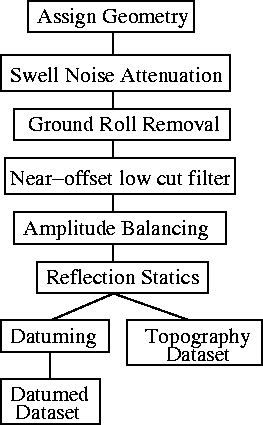




Next: Migration Velocity Profile
Up: Husky 2D Land Dataset
Previous: Husky 2D Land Dataset
Although the Husky dataset is of high quality, significant
preprocessing is required to enhance signal quality. Data processing
steps, applied using the proprietary OMEGA processing package, are
listed in Figure ![[*]](http://sepwww.stanford.edu/latex2html/cross_ref_motif.gif) .
After geometry assignment, a swell-noise debursting algorithm was
applied in the shot- and receiver-record and CMP domains to reduce
anomalous low-frequency noise. Ground roll suppression and
near-offset bandpass filtering subsequently reduced ground roll and
airwave noise. Application of de-spiking and surface-consistent
amplitude modules improved the relative amplitude balance across the
shot-record and offset panels.
.
After geometry assignment, a swell-noise debursting algorithm was
applied in the shot- and receiver-record and CMP domains to reduce
anomalous low-frequency noise. Ground roll suppression and
near-offset bandpass filtering subsequently reduced ground roll and
airwave noise. Application of de-spiking and surface-consistent
amplitude modules improved the relative amplitude balance across the
shot-record and offset panels.
flow
Figure 2 Husky data processing flow
chart.
|
|  |

Static time shifts were then complied to generate a second datumed
dataset. This dataset was generated by applying two static time
shifts - one from the source/receiver location to a intermediate CMP
datum, and a second to a constant elevation of -1800 m (assuming a
3200 m/s replacement velocity layer). Reflection statics (that
optimized the power of the constant velocity scan stack) also were
applied to both datasets. Figure ![[*]](http://sepwww.stanford.edu/latex2html/cross_ref_motif.gif) presents a
comparison of a shot-record before and after data processing.
presents a
comparison of a shot-record before and after data processing.
data_examp
Figure 3 Sample Husky dataset
shot-record before (left) and after (right) preprocessing.










Next: Migration Velocity Profile
Up: Husky 2D Land Dataset
Previous: Husky 2D Land Dataset
Stanford Exploration Project
10/31/2005
![[*]](http://sepwww.stanford.edu/latex2html/cross_ref_motif.gif) .
After geometry assignment, a swell-noise debursting algorithm was
applied in the shot- and receiver-record and CMP domains to reduce
anomalous low-frequency noise. Ground roll suppression and
near-offset bandpass filtering subsequently reduced ground roll and
airwave noise. Application of de-spiking and surface-consistent
amplitude modules improved the relative amplitude balance across the
shot-record and offset panels.
.
After geometry assignment, a swell-noise debursting algorithm was
applied in the shot- and receiver-record and CMP domains to reduce
anomalous low-frequency noise. Ground roll suppression and
near-offset bandpass filtering subsequently reduced ground roll and
airwave noise. Application of de-spiking and surface-consistent
amplitude modules improved the relative amplitude balance across the
shot-record and offset panels.

